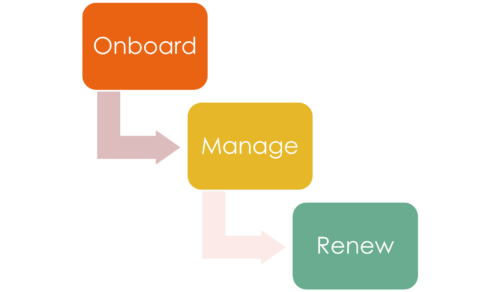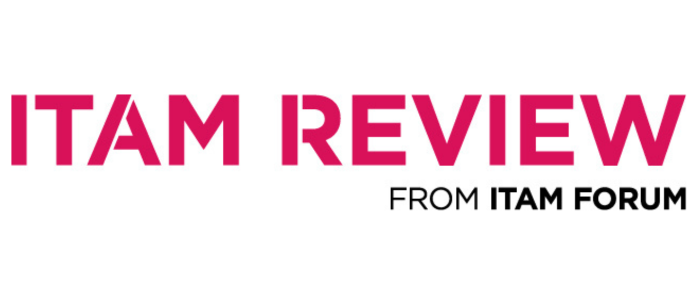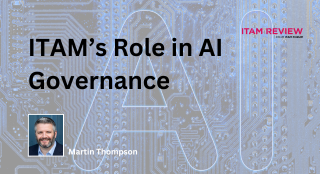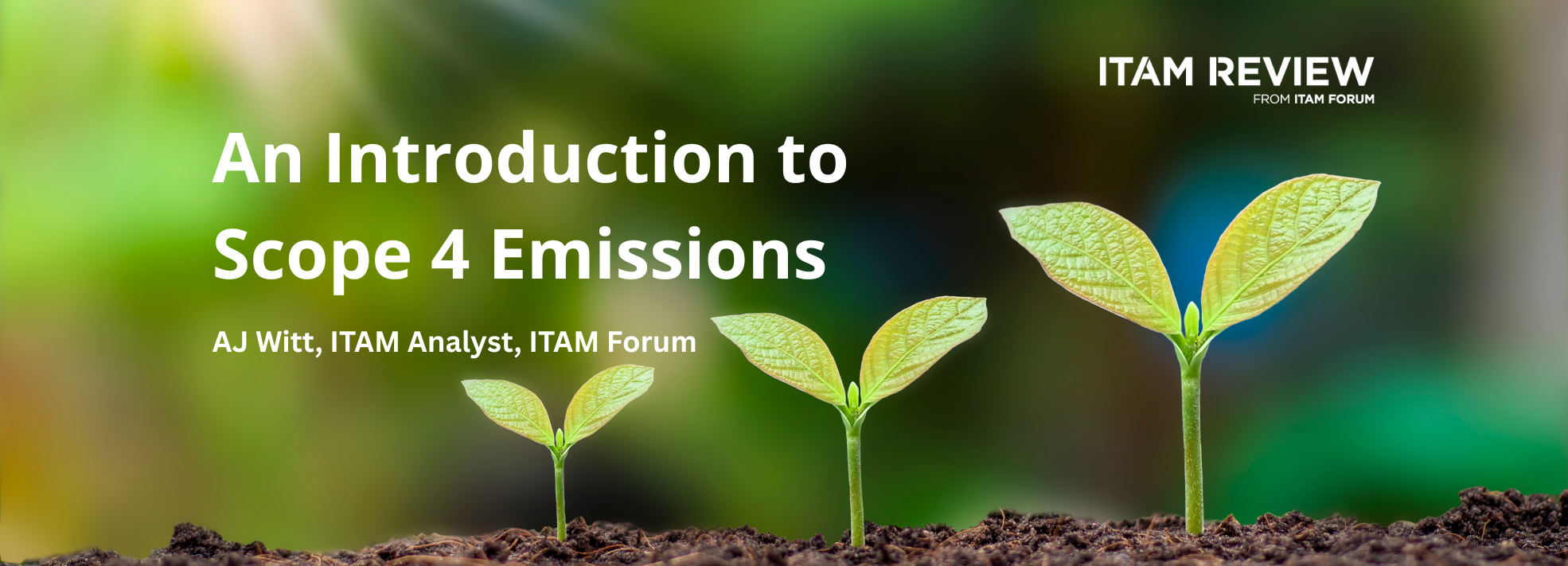How to renew a SaaS contract
One of the big changes brought about by the ongoing shift to subscription licensing is the frequency of contract renewals. Enterprise SaaS Management tool providers such as Zylo estimate that large organisations process 15 renewals per week. With over 600 applications in use at large organisations this figure isn’t surprising. Furthermore, SaaS Management teams also need to address the impact of automatic renewals on expenditure. This article provides practical advice on how to manage SaaS renewals to maximise value from investments in subscription software. Also provided is an extensible Airtable application based on this article. This application is provided “as-is” for educational and personal use only.
SaaS Renewals Lifecycle
SaaS Renewals are part of the software lifecycle. There are actions you can take at several stages in the lifecycle to ensure you’re able to approach a renewal from a position of informed strength.

SaaS contract onboarding
Efficient SaaS renewals start at the point you sign the agreement and take receipt of the subscriptions. Ensure at this point that you have a record of the agreement and terms related to the renewal.
Key information required includes:
Application Name & Tier
What is the name of the application? If applicable, which tier has been purchased?
Seats/Other Metric
How many seats have been purchased? Or whatever metric the application uses.
Unit Price & Contract Value
To negotiate a renewal, you first need to know how much you’re paying. Noting this at the start of the contract enables you to prioritise high-value contracts in the renewals pipeline.
Renewal Date
With so many renewals to process, it is critical that renewals are planned. Noting the renewal date enables you to build a renewal calendar/pipeline, enabling you to plan for peak periods. For example, these might be at your organisations’ financial year-end.
Notice/Variation terms
Knowing the renewal date is only part of the story, you also need to note notice and variation terms. For example, a contract may stipulate that cancellations require 60 days’ notice so that is a more critical date than the renewal date.
Price holds
Typically, the price for a SaaS app will hold for the duration of the contract term. With SaaS contracts often running on an annual or even monthly basis, this information is important in order to set budgets and forecast TCO for an application.
Contract minimums
Enterprise SaaS contracts may include contract minimums – commitments to a certain number of seats, for example. If you’re optimising a renewal this becomes important because it may mean you can’t drop subscriptions that aren’t being used.
Tier boundaries
SaaS pricing can be unusual in that the price may go up the more you use it. This is quite unlike perpetual software where volume discounts are the norm. A common example is API pricing, whereby publishers provide a free tier that’s limited to a certain number of calls per month. Likewise, application software may have a seat rather than a feature-limited free tier. If you’re growing usage of an application rapidly this will become important because as usage grows you may be forced out of the free tier.
Purpose
What is the software being used for? Who uses it? What business process does it support? How critical is it to business operations?
Category
What does the app do? For example, is it a file sharing, collaboration, or graphic design application? Knowing this enables better lifecycle management because we know what it does and potentially what the alternatives are.
Owner
Often, a SaaS app won’t be owned by IT. For example, data science teams may manage their own application stack. Knowing who owns an application enables you to engage with them to discuss the renewal and how the subscription is managed through its lifecycle.
Publisher status
Knowing who the publisher enables you to select an appropriate negotiation strategy. Is this a partner, a strategic supplier, a tactical solution, or just a transactional vendor? Just as we would for an EA or ULA renewal, knowing what other solutions we’re using from a vendor informs the approach to renewal negotiations.
For an Airtable Universe application based around this Renewals Checklist please click here. This application is provided “as-is” for educational and personal use only.
Management phase
With the new software subscription onboarded our focus shifts to actively managing the contract. In this phase, we are primarily concerned with tracking usage of the software. Key data for usage tracking includes:
- Active Users
- Feature Use
- Available licenses
- Tier boundaries
- Alternative Solutions
The purpose of the management phase of SaaS renewals is to track how the application is embedding over time. Trend information helps you determine renewal volumes and supports negotiations at renewal time. Large SaaS providers such as Salesforce will often price renewals on an agreed annual uplift in seats – if you know your usage trend you can use that to your advantage.
Likewise, if an application isn’t embedding, or usage is dropping away, that’s important in the management phase. Early notice of this means you can notify application owners that they’re not getting the best value from their software investment. For company-wide applications, this might enable action to be taken in the form of a training or communication programme. Similarly, if you’re seeing usage of an alternative solution growing you can build that into your renewal strategy. For example, you may see Webex usage declining by 15% per month, with Zoom increasing by 20% – that indicates that you should be reducing commitment to Webex and planning a price hold based on a contract minimum for Zoom.
Renewal Phase
By now, you have richly detailed entitlement records for your SaaS application – gathered in the Onboard phase – alongside equally rich usage data. We’ve got all we need to process the renewal efficiently. Essentially, we’ve answered the questions:
- What do we own?
- What are we using?
- What do we need?
Now, it’s time to renew. Our first step is to ensure we set our scope appropriately. As noted in the opening paragraph, most organisations will have several SaaS renewals due each week. Clearly, it isn’t cost-effective for a SaaS Management team to pay full attention to every renewal. It’s important therefore that criteria are established to determine where you get involved. These criteria might include:
- Contract Value
- Business Criticality
- Renewal Time Horizon
If an application is in the top ten by contract value, it probably deserves your attention. However, if it’s a critical application for your business that will influence how you negotiate the renewal. You don’t enter a renewal negotiation with Salesforce or Microsoft in the same way as you do with a non-critical service provider. Likewise, if the application is due for renewal next week, there’s probably very little you can do to add value to the renewal process – there just isn’t enough time to act. This highlights the absolute importance of having an accurate renewals pipeline.
With your scope defined you should have a set of renewal targets for action. The next step is to contact the publisher or reseller to initiate the renewal process. It’s good to do this early, and that’s made possible by the rich data you’ve gathered through the onboarding and management phase. By doing it early you’ve got more opportunity to negotiate with the publisher or vendor because they’ve got more time to determine how to meet their commercial and other goals with you as a customer. Forewarned is forearmed but equally important is building a partnership relationship with SaaS providers, particularly if their apps are business-critical. Unlike perpetual software there’s no option to stop paying maintenance and support on SaaS licenses; if you don’t pay you lose access to the service.
Renewals from the provider’s perspective
When negotiating it’s useful to understand what success looks like from the other side of the table. Customer Success Metrics (CSM) are primarily what matters to SaaS providers and their investors. For a primer on CSM for SaaS providers see this article from Databox – one of the key measures discussed is Customer Lifetime Value (CLV). CLV is maximised when customers renew year after year, and this is clearly a strong incentive to get “one more year” from a customer. Use this to your advantage.
Another key metric is Churn Rate – the proportion of customers who don’t renew in each time period. Acquiring customers is much more expensive than retaining an existing one and SaaS companies and their investors also pay close attention to their Churn Rate.
Meeting in the middle
The art of negotiation is to come to an outcome that both parties are happy with. If you have great data, use that data to get to that outcome. For example, use Churn Rate and CLV to leverage one of the essential properties of SaaS – that it’s not “sticky” due to solution proliferation and short-term contracts. SaaS Management tool provider Blissfully report that churn rate for the applications used by their customers is around 30% per year. Investors expect revenue and customer number growth and it’s no good pouring water into a bucket with a big hole in the base. SaaS providers will always seek to minimise churn so use that to your advantage.
Let’s look at three renewal strategies – Commit, Churn, and Automate – in more detail.
Committing
If you know you’re committed to an application for the next three years, because your data shows that adoption is high and user numbers are growing, then you can sign a three-year deal with confidence. And, just as with perpetual contracts, a three-year deal gives your salesperson maximum flexibility on price because they now know with certainty that you’re not going to churn next December. You’ll end up with a great deal and the provider will be happy too.
Churning
However, what if things aren’t going well with the application and you’re looking to switch to a different solution? Firstly, the usual discounts still apply when switching providers. You’ll be rewarded for jumping ship if you negotiate correctly. If jumping ship isn’t desirable – and it often isn’t due to the cost of switching in terms of business disruption – your data also enables you to let the incumbent know early in the sales cycle that you’re not intending to renew. This is important because it gives them time to come up with a strategy to stop you churning. That might be help with addressing any issues your users are having with adopting the solution or upselling you to a higher tier at a heavy discount and providing you with access to features which might solve the usability issues impacting adoption. Either way, you win, as does the provider.
Automation
Commit and Churn are the extreme outcomes of a SaaS renewal cycle. What about the long tail of renewals? Those tactical, transactional renewals that are low value and used by a small number of users? Clearly, ITAM & Procurement teams don’t have the resources to focus on these. This is why setting your involvement scope is important – so that you don’t sweat the small stuff and get caught up doing things that don’t add value.
Fortunately, “do nothing” is the default behaviour SaaS providers expect. Generally, subscriptions are set to auto-renew, meaning no action is required. This doesn’t mean that you should just let contracts renew without some oversight. Your renewals calendar is vital, providing a quick status check on every subscription – what do we own, what are we using, when is it due, what’s the renewal value. Set up alerts correctly and this becomes a Monday morning task that will take maybe 30 minutes to complete. Use the sample renewals application available here to do this. This application is provided “as-is” for educational and personal use only.
Conclusion
Getting to grips with SaaS Renewals starts with gathering key data about each contract at the point it’s signed. Using this data to build a renewals calendar enables an ITAM team to plan SaaS Renewals effectively and to target their resources to achieve best value. Whilst this can be done with simple tools such as our Renewals Tracker, there are many comprehensive commercial tools available that will provide you with the rich usage information needed to ensure SaaS Renewals efficiently meet current and future demand. For more SaaS Management tools please see The ITAM Review Marketplace.
Can’t find what you’re looking for?
More from ITAM News & Analysis
-
Addressing the SaaS Data Gap in FinOps FOCUS 2.1
I recently reported on the FinOps Foundation’s inclusion of SaaS and Datacenter in its expanded Cloud+ scope. At that time, I highlighted concerns about getting the myriad SaaS companies to supply FOCUS-compliant billing data. A couple ... -
The Future of ITAM
As an ITAM Industry Analyst, I’m often asked what ITAM’s future looks like. This can be a tough question to answer because when it comes to the future, there are endless possibilities. Often, it seems, some ... -
The Allure of the Cloud: What are We Chasing?
When I ask ITAM professionals about their transition to the cloud, the responses are often similar. “It wasn’t my decision.” It’s striking how many people feel this way—decisions about moving from on-premises solutions to the cloud ...
Podcast
ITAM training
Similar Posts
-
The M&S Cyberattack: How IT Asset Management Can Make or Break Your Recovery
Marks & Spencer (M&S), the iconic UK retailer, recently became the latest high-profile victim of a devastating cyberattack. Fellow retailers The Co-Op and Harrods were also attacked. Recent reports suggest the rapid action at the Co-Op ... -
AI in ITAM: Insightful Signals from the Front Line
During our Wisdom Unplugged USA event in New York in March 2025, we engaged ITAM professionals with three targeted polling questions to uncover their current thinking on Artificial Intelligence—what concerns them, where they see opportunity, and ... -
How ISO/IEC 19770-1 Can Help Meet FFIEC Requirements
In the world of ITAM, the regulatory spotlight continues to intensify, especially for financial institutions facing increasing scrutiny from regulatory bodies due to the growing importance of IT in operational resilience, service delivery, and risk management. ... -
An Introduction to Scope 4 Emissions
Executive Summary For ITAM teams, sustainability is a core responsibility and opportunity. Managing hardware, software, and cloud resources now comes with the ability to track, reduce, and report carbon emissions. Understanding emission scopes—from direct operational emissions ...




